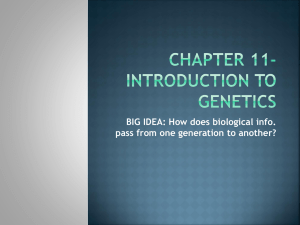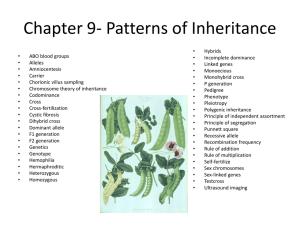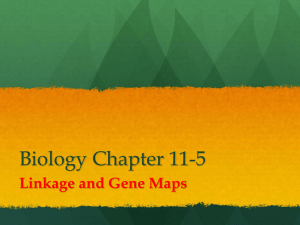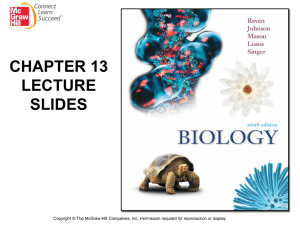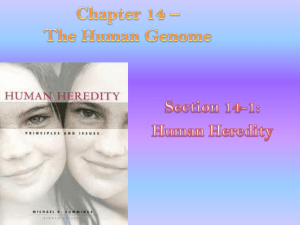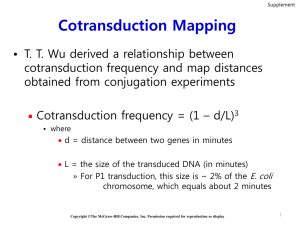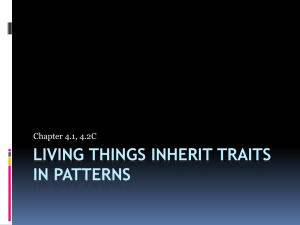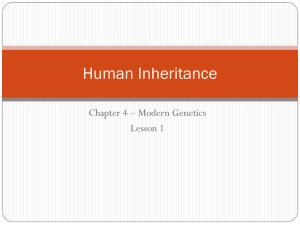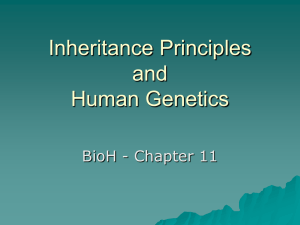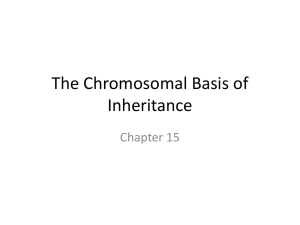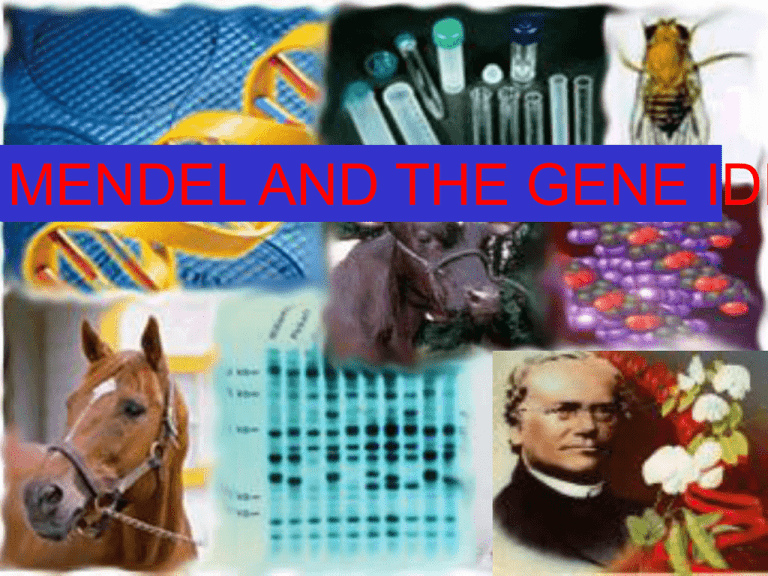
MENDEL AND THE GENE IDE
Introduction
1.
Mendel brought an experimental
and quantitative approach to genetics
2. By the law of segregation, the two alleles for
a character are packaged into separate gametes
3. By the law of independent assortment, each
pair of alleles segregates into gametes
independently
4. Mendelian inheritance reflects rules of
probability
5. Mendel discovered the particulate behavior of
genes
Introduction
• The current theory for the mechanism for the
transmission of genetic material was the “blending”
hypothesis.
• This hypothesis proposes that the genetic material
contributed by each parent mixes in a manner
analogous to the way blue and yellow paints blend to
make green.
•Mendel proposed an alternative model, “particulate”
inheritance
•This proposes that parents pass on discrete heritable units
- genes - that retain their separate identities in offspring.
•Genes can be sorted and passed on, generation after
generation, in undiluted form.
Blending Hypothesis: 1800s -suggested that traits of parents
mix to form intermediate traits in offspring.
Parents
Offspring
Red flower x White flower
Pink flower
Tall height x Short height
Medium height
Blue bird x Yellow bird
Fair skin x dark skin
Green birds
Medium skin color
If blending always occurred, eventually all extreme characteristics
would disappear from the population.
Modern genetics began in an abbey garden,
where a monk names Gregor Mendel
documented mechanisms of inheritance.
Gregor
Mendel:
Established
genetics as
a science in
1860s.
Considered
the founder
of modern
genetics.
1857
mendel
• Mendel grew up on a small farm in what
is today the Czech Republic.
• In 1843- entered monastery.
• He studied at the University of Vienna
from 1851 to 1853.
• The monks at this monastery had a long
tradition of interest in the breeding of
plants, including peas.
• Around 1857, Mendel began breeding
garden peas to study inheritance.
Pea plants have several advantages for genetics.
• Pea plants are available in many varieties with distinct
heritable features (characters) with different variants
(traits).
• Short generation time, little space needed, cross or
self fertilize
Overview of Mendel’s experiments.
-Mendel looked at 7 traits-
• Cross fertilization and self fertilization
He took a true
breeding purple
flower plant and
crossed it with a
true breeding white
flower plant.
He called these the
parent generation (P
generation)
What do you think
the offspring looked
like?
Pollen
hybridize
X
F1
Allowed to self-pollinate
F2
Mendel concluded:
1. Something is being passed from
parent to offspring.
• He called these “Factors”
2. Sometimes you can see “it” and
sometimes you can’t see “it”.
• If you can see it- it is dominant.(T)
• If it’s there and you can’t see itit’s recessive.(t)
Purple flower is a dominant trait and white flower is a
recessive trait.
Each Version of the factor, now
known as gene, is called an Allele.
Mendel developed a hypothesis to explain these
results that consisted of four related ideas.
1. Alternative versions of genes (different alleles)
account for variations in inherited characters.
• Different alleles vary somewhat in the sequence of nucleotides at
the specific locus of a gene
2. For each character, an
organism inherits two
alleles, one from each
parent.
3. If two alleles differ, then
one, the dominant allele, is
fully expressed in the organism’s appearance.
•The other, the recessive allele,
no noticeable effect on the
appearance.
organism’s
has
4. The two alleles for each character
segregate (separate) during gamete
production (meiosis).
Mendel’s quantitative analysis of F2 plants revealed the
two fundamental principles of heredity:
the law of segregation & the law of independent assortment.
Law of segregation- the two alleles for a
character are packaged into separate gametes
• If the blending model were correct, the F1 hybrids from
a cross between purple-flowered and white-flowered
pea plants would have pale purple flowers.
• Instead, the F1 hybrids
all have purple flowers,
just as purple as the
purple-flowered
parents.
Law of segregation- the two alleles for a
character are packaged into separate gametes
• The white trait, absent in the F1, reappeared in the F2.
• Based on a large sample size, Mendel recorded in the F2
plants:
• 705 purple-flowered
• 224 white-flowered
• 3:1 ratio (phenotype)
The reappearance of
white-flowered plants in
the F2 generation
indicated that the
heritable factor for the
white trait was not diluted
or “blended” by coexisting
with the purple-flower
factor in F1 hybrids.
Law of segregation-the two alleles for a character
are packaged into separate gametes
This segregation
of alleles
corresponds to
the distribution
of homologous
chromosomes to
different
gametes in
meiosis.
packaged into
separate gametes
USING THE Law of segregation………..
• A Punnett square
predicts the results
of a genetic cross
between individuals
of known genotype.
PRACTICE:
•DRAGON Genetics
#1 & 2
Genetics Practice #8,17
• Two heterozygotes • 3:1 ratio of
dominant: recessive
phenotypes
• 1:3:1 genotypes
• When crossing two pure breeding plants,
Mendel found similar 3 to 1 ratios among
F2 offspring when he conducted crosses for
six other characters, each represented by
two different varieties.
Predicting the genotype of an organism with the
dominant phenotype:
what’s the genotype?????
• The organism must have at least one dominant allele, but it
could be homozygous dominant or heterozygous.
A testcross, breeding a
homozygous recessive
with dominant phenotype,
but unknown geneotype,
can determine the identity
of the unknown allele.
The law of independent assortment- each pair of
alleles segregates into gametes independently
•Alleles that are not on the same chromosome
•Ex. The alleles for height segregate independently
from the alleles of a gene for color.
AS long as the genes are on separate
chromosomes, the separation during meiosis is
RANDOM.
The law of independent assortment- each pair of
alleles segregates into gametes independently
-During meiosis,
the chromosomes
line up randomly
during metaphase
II.
-So, depending on
how they line, this
determines the
alleles in each
gamete.
The law of independent assortment- each pair of
alleles segregates into gametes independently
• Mendel’s experiments that followed the
inheritance of flower color or other
characters focused on only a single
character via monohybrid crosses.
• He conducted other experiments in which
he followed the inheritance of two different
characters, a dihybrid cross.
animation
• If no independent assortment:
• The F2 offspring (in dihybrid)
would only
produce two phenotypes
in a 3:1 ratio, just like a
monohybrid cross.
• This was not consistent
with Mendel’s results.
animation
Mendel crossed truebreeding plants that had
yellow, round seeds (YYRR)
with true-breeding plants
that has green, wrinkled
seeds (yyrr).
When sperm with four
classes of alleles and ova with
four classes of alleles
combined, there would be 16
equally probable ways
in which the alleles
can combine in
the F2 generation.
• These combinations
produce four distinct
phenotypes in a 9:3:3:1
ratio.
• This was consistent
with Mendel’s results.
Black-B
Brown-b
Long hair-S
Short-s
• Cross two purebred
guinea pigs.
Brown-long hair x
Black-short hair
• Give phenotype and
genotype ratios.
Mendelian inheritance reflects rules
of probability
• Mendel’s laws reflect the laws of probability.
• The probability scale ranged from zero (an event
with no chance of occurring) to one (an event that is
certain to occur).
• The probability of tossing heads with a normal coin is ½.
• The probability of rolling a 3 with a six-sided die is 1/6,
and the probability of rolling any other number is
1 - 1/6 = 5/6.
• When tossing a coin, the outcome of one toss
has no impact on the outcome of the next toss.
• Each toss is an independent event, just like the
distribution of alleles into gametes.
• Like a coin toss, each ovum
from a heterozygous parent
has a ½ chance of carrying
the dominant allele and a
½chance of carrying the
recessive allele.
• The same odds apply to
the sperm.
•
Rule of multiplication to determine the chance
that two or more independent events will occur
together in some specific combination.
1.
Compute the probability of each independent event.
2. Multiply the individual probabilities.
•
The probability that two coins tossed at the same
time will land heads up is:
½ x ½ = ¼.
•
Similarly, the probability that two heterozygous
pea plants (Pp) will produce a white-flowered
offspring (pp) depends on an ovum with a white
allele mating with a sperm with a white allele.
½ x ½ = ¼.
Rule of multiplication also applies to dihybrid crosses.
• For a heterozygous parent (YyRr) the probability of
producing a YR gamete is ½ x ½ = ¼.
• We can use this to predict the probability of a
particular F2 genotype without constructing a 16part Punnett square.
•The probability that
an F2 plant will have
a YYRR genotype
from heterozygous
parents is
•1/16 (¼ chance for a
YR ovum and ¼
chance for a YR
sperm).
• Examples:
• An organism had three independently
assorting traits: AaBbCc. What fraction of its
gamete will contain ABC?
• 1/8
• What about an organism with AABcCc? What
fraction of its gamete will contain ABC?
• 1/4
Rule of addition:
When more than one arrangement of
the events producing the specified outcome is possible, the
individual probabilities are added.
• determine the probability of an offspring having
two recessive phenotypes for at least two of three
traits resulting from a trihybrid cross between pea
plants that are PpYyRr and Ppyyrr.
• There are five possible genotypes that fulfill
this condition: ppyyRr, ppYyrr, Ppyyrr,
PPyyrr, and ppyyrr.
• Determine probability of each and then add
together.
• For ppYyrr: 1/4 × 1/2 × 1/2 = 1/16.
• For Ppyyrr: 1/2 × 1/2 × 1/2 = 1/8 or 2/16.
• For PPyyrr: 1/4 × 1/2 × 1/2 = 1/16.
• For ppyyrr: 1/4 × 1/2 × 1/2 = 1/16.
• Therefore, the chance that a given offspring
will have at least two recessive traits is 1/16 +
2/16 + 1/16 + 1/16 = 6/16.
Website
THE CHROMOSOMAL BASIS
OF INHERITANCE
1.Morgan traced a gene to a specific
chromosome
2. Linked genes tend to be inherited
together because they are located on the
same chromosome
3. Independent assortment of chromosomes
and crossing over produce genetic
recombinants
4. Geneticists use recombination data to map
a chromosome’s genetic loci
Introduction
• It was not until 1900 that biology
finally caught up with Gregor Mendel.
• Mendel’s hereditary factors are the
genes located on chromosomes.
Mendelian inheritance has its physical basis in the
behavior of chromosomes during sexual life cycles
•
Around 1900, cytologists and geneticists began
to see parallels between the behavior of
chromosomes and the behavior of Mendel’s
factors.
Around 1902,
Walter Sutton,
Theodor Boveri,
and others noted
these parallels
and a chromosome
theory of
inheritance began
to take form.
CHROMOSOMAL THEORY OF INHERITANCE
1. Chromosomes are carriers of traits and each
chromosome could carry the genes for MANY
traits.
2. Alternate forms or ALLELES of a gene are
located on matched pairs of chromosomes.
3. When chromosome pairs separate in meiosis,
each chromosome carries its set of alleles to
a gamete.
4. Genes of the same chromosome move
together; Genes on different chromosomes
assort independently.
Morgan traced a gene to
a specific chromosome
• He was the first to associate
a specific gene with a specific
chromosome.
• Worked with Drosophila
melanogaster
• Prolific breeders & have a
generation time of two weeks.
• 3 pairs of autosomes and a pair of
sex chromosomes
•
Produces about 100 offspring per egg lay – good statistics!
•
Easy/inexpensive to raise
•
Chromosomes are VERY large and easy to see and locate
•
Sexes are easily distinguished
--female is larger
--shapes of abdomen identify sexes at a glance
Morgan spent a year looking for variant individuals
among the flies he was breeding.
• He discovered a single male fly with white eyes
instead of the usual red.
• The normal phenotype is the wild type.
• Alternative
traits mutant
phenotypes.
Morgan’s Experiments & Findings
• When Morgan crossed his white-eyed male with a redeyed female, all the F1 offspring had red eyes,
• The red allele appeared dominant to the white allele.
• Crosses between the F1 offspring produced the classic
3:1 phenotypic ratio in the F2 offspring.
• Surprisingly, the white-eyed trait appeared only
in males.
• All the females and half the males had red eyes.
• Morgan concluded that a fly’s eye color was
linked to its sex.
• Morgan deduced that the gene with the white-eyed
mutation is on the X chromosome, a sex-linked gene.
•Females (XX) may have two
red-eyed alleles and have red
eyes or may be heterozygous
and have red eyes.
•Males (XY) have only a single
allele and will be red eyed if
they have a red-eyed allele or
white-eyed if they have a
white-eyed allele.
Sex Chromosomes
1.Sex-linked genes have unique patterns of
inheritance
2.The chromosomal basis of sex varies with the organism
• In addition to their role in
determining sex, the sex
chromosomes, especially the X
chromosome, have genes for
many characters unrelated to sex.
• Males are hemizygous for the X
chromosome (XY)
Karyotype
• If a sex-linked trait is due to a recessive allele, a
female will have this phenotype only if homozygous.
• Heterozygous females will be carriers.
• Because males have only one X chromosome
(hemizygous), any male receiving the recessive allele
from his mother will express the trait.
• The chance of a female inheriting a double dose of
the mutant allele is much less than the chance of a
male inheriting a single dose.
• Therefore, males are far more likely to inherit sexlinked recessive disorders than are females.
• Hemophilia &
Colorblindness are all
on the X-chromosome
• Several serious human
disorders are sex-linked.
• Duchenne muscular
dystrophy affects one in
3,500 males born in the
United States.
• Affected individuals
rarely live past their
early 20s.
•due to the absence of an X-linked gene for a key
muscle protein, called dystrophin.
•a progressive weakening of the muscles and a loss of
coordination.
• Although female mammals inherit two X chromosomes, only one X
chromosome is active.
• Therefore, males and females have the same effective dose (one copy ) of genes
on the X chromosome.
• During female development, one X chromosome per cell condenses into a
compact object, a Barr body.
• This inactivates most of its genes.
• Barr body occurs randomly and independently
Animation
• If a female is heterozygous for a sex-linked trait, approximately half her cells
will express one allele and the other half will express the other allele.
• The condensed Barr body chromosome is reactivated in ovarian cells that
produce ova.
• In humans, this mosaic pattern is evident in women who are heterozygous for a
X-linked mutation that prevents the development of sweat glands.
• Hypohidrotic ectodermal dysplasia
• A heterozygous woman will have patches of normal skin and skin patches
lacking sweat glands.
Cool example: the orange and black pattern on
tortoiseshell cats is due to patches of cells
expressing an orange allele while others have
a nonorange allele.
• In human and other
mammals, there are two
varieties of sex
chromosomes, X and Y.
• XX= female.
XY= male.
• This X-Y system of
mammals is not the only
chromosomal mechanism of
determining sex.
• Other options include
• X-0 system (Grasshoppers,
roaches, and other insects)
• Z-W system (Birds, insects
like butterflies, frogs and some
species of fish)
• the haploid-diploid system.
•In humans, the anatomical signs of sex first appear when
the embryo is about two months old.
• In individuals with the
SRY gene (sex-
determining region of
the Y chromosome), the
generic embryonic
gonads are modified
into testes.
• In individuals lacking
the SRY gene, the
generic embryonic
gonads develop into
ovaries.
Multiple
Alleles genes that
exist in more
two allelic
forms
• Practice Problems
Linked genes tend to be inherited together
because they are located on the same
chromosome
• Chromosome have 100s or
1000s of genes.
• Genes located on the same
chromosome are called
linked genes
• tend to be inherited together
because the chromosome is
passed along as a unit.
• Results of crosses with linked genes deviate
from those expected according to
independent assortment.
• Morgan observed this linkage (and its deviations)
when he followed the inheritance of characters
for body color and wing size.
• The wild-type body color is gray (b+) and the mutant black (b).
• The wild-type wing size is normal (vg+) and the mutant has
vestigial wings (vg).
• Morgan crossed F1 heterozygous females
(b+bvg+vg) with homozygous recessive males
(bbvgvg).
• (according to Mendelian genetics, what
genotypes should he get in the F2
generation?)
• According to independent
assortment, this should
produce 4 phenotypes in
a 1:1:1:1 ratio.
• THAT’ NOT WHAT HE
OBSERVED
• He observed a large number
of wild-type (gray-normal)
and double-mutant (blackvestigial) just like the
parents.
• Fewer recombinations than
expected!!!!!
Morgan’s conclusions:
•He reasoned that body color
and wing shape are usually
inherited together because
their genes
are on the
same chromosome
(Linked).
•The other two phenotypes (gray-vestigial and
black-normal) were fewer than expected from
independent assortment (and totally unexpected
from dependent assortment).
• These new phenotypic
variations must
be the
result of crossing over.
• The results of Morgan’s testcross for body color
and wing shape did not conform to either
independent assortment or complete linkage.
• Under independent assortment the testcross should
produce a 1:1:1:1 phenotypic ratio.
• If completely linked, we should expect to see a 1:1:0:0
ratio with only parental phenotypes among offspring.
• Most of the offspring had parental
phenotypes, suggesting linkage between
the genes.
• However, 17% of the flies were recombinants,
suggesting incomplete linkage.
• Morgan proposed that some mechanism
occasionally exchanged segments between
homologous chromosomes.
• This switched alleles between homologous chromosomes.
• The actual mechanism, crossing over during prophase I,
results in the production of more types of gametes than
one would predict by Mendelian rules alone.
• Crossing over accounts for the recombinant
phenotypes in Morgan’s testcross.
Geneticists can use recombination data to
map a chromosome’s genetic loci
• One of Morgan’s students,
Alfred Sturtevant, used
crossing over of linked genes
to develop a method for
constructing a genetic map.
• This map is an ordered list of
the genetic loci along a
particular chromosome.
Alfred Sturtevant
• Sturtevant hypothesized that the frequency of
recombinant offspring reflected the distances
between genes on a chromosome.
• The farther apart two genes are, the higher the
probability that a crossover will occur between
them and therefore a higher recombination
frequency.
• The greater the distance between two
genes, the more points between them
where crossing over can occur.
• Sturtevant used recombination frequencies
from fruit fly crosses to map the relative
position of genes along chromosomes, a linkage
map.
• Sturtevant used the testcross design to map the
relative position of three fruit fly genes, body color
(b), wing size (vg), and eye color (cn).
• The recombination frequency between cn and b is 9%.
• The recombination frequency between cn and vg is 9.5%.
• The recombination frequency between b and vg is 17%.
• The only possible
arrangement of these
three genes places
the eye color gene
between the other two.
• Expressed the distance
between genes, the
recombination frequency,
as map units.
• One map unit (sometimes called a centimorgan) is equivalent to
a 1% recombination frequency.
A couple of points…..
• Some genes on a chromosome are so far apart
that a crossover between them is virtually
certain.
• In this case, the frequency of recombination reaches
is its maximum value of 50% and the genes act as if
found on separate chromosomes and are inherited
independently.
• In fact, several genes studies by Mendel are located on the same
chromosome.
• For example, seed color and flower color are far enough apart
that linkage is not observed.
• Plant height and pod shape should show linkage, but Mendel
never reported results of this cross.
A couple of points…..
• Genes located far apart on a chromosome are mapped
by adding the recombination frequencies between the
distant genes and intervening genes.
• Sturtevant and his
colleagues were able
to map the linear
positions of genes in
Drosophila into four
groups, one for each
chromosome.
Your turn to do some
MAPPING……
Anaylsis:
• If the two genes showed
independent assortment, we
would hypothesize a 1:1:1:1
ratio of phenotypes from the
testcross done.
• Instead, most resemble the
phenotypes of the two original
parents (the normal round
eyes and no tooth, and the
double mutant vertical eyes
and tooth). We must conclude
that the genes do not assort
independently.
• How many map units between
these 2 linked genes?
Solution
Another practice problem
Determine the sequence of genes along a
chromosome based on the following
recombination frequencies:
• A-B, 8 map units
• A-C, 28 map units
• A-D, 25 map units
• B-C , 20 map units
• B-D, 33 map units.
Solution
Steps for solving
1.
Choose the greatest map distance (in this case 33) and
place the genes involved at opposite ends of a line
representing a portion of the chromosome in question
2.
Now choose a gene combination with either B or D in it.
For example: A-D = 25 map units
a)
3.
Since A-B is only 8 map units, A must be
in the middle
Now choose on that has A in it :
a)
b)
You already have A-D and A-B, so all that is left is A-C, but where
does it go…which side?
Since the distance from A to B is about 8 and the distance from C
to B is less than the distance from A to B the C-gene must be to
the left of the B-gene.
Practice
• A phenotypic wild-type fruit fly (heterozygous
for gray body color and red eyes) was mated
with a double mutant black fruit fly with purple
eyes.
• The offspring were as follows: wild-type, 721;
black-purple, 751; gray-purple, 49; black-red,
45.
(a) What is the recombination frequency
between these genes for body color and
eye color?
(b) Are these genes on the same
chromosome? If so, how far apart are
they?
Solution
Genotypes:
• b+ = gray body
• b = black body
• pr+= red eyes
• pr = purple eyes
Total flies = 1566
(a) The percent recombination is therefore 6%
6
1. Alterations of chromosome number or
structure cause some genetic disorders
Nondisjunction
Aneuploidy
Polyploidy
Nondisjunction
• Nondisjunction occurs when problems with the
meiotic spindle cause errors in daughter cells.
• This may occur if tetrad chromosomes do not separate
properly during meiosis I.
• Alternatively, sister chromatids may fail to separate during
meiosis II.
Consequencesome gametes
receive two of
the same type
of chromosome
and another
gamete receives
no copy.
Aneuploidy
• Aneuploidy =Abnormal chromosome #.
• Trisomic cells have 3 copies of a particular
chromosome type
Down syndrome, Klinefelter’s
• Monosomic cells have only 1 copy of a particular
chromosome type.
Turner syndrome
condition in which a female
does not have the usual pair
of two X chromosomes
• Can occur during failures of the mitotic spindle.
Aneuploidy occurs during cell division when the chromosomes
don't separate properly (nondisjunction) between the two
cells. Chromosome abnormalities occur in 1 of 160 live births,
the most common being extra chromosomes 21 (Down
syndrome), 18 (Edwards syndrome) and 13 (Patau syndrome).
Aneuploidy-trisomy
• Down syndrome, is due to three copies of chromosome 21.
• Caused by nondisjunction
• It affects one in 700 children born in the United States.
• Although chromosome 21 is the smallest human
chromosome, it severely alters an individual’s phenotype
in specific ways.
Aneuploidy
-trisomy
Klinefelter Syndrome
• Affects only males.
• Caused by nondisjunction.
• Males who have Klinefelter
syndrome have an extra X
chromosome (XXY), giving them a total
of 47 instead of the normal 46 chromosomes
•Develop as males with subtle characteristics that become apparent during
puberty. They are often tall and usually don't develop secondary sex
characteristics, such as facial hair or underarm and pubic hair. The extra X
chromosome primarily affects the testes, which produce sperm and the male
hormone testosterone.
•At puberty, men with this syndrome often develop more breast tissue than
normal, have a less muscular body, and grow very little facial or body hair.
Most are sterile because they cannot produce sperm. Learning disabilities are
also a common problem for them.
•Hormone replacement: Teenagers are typically given testosterone injections to
replace the hormone that would normally be produced by the testes.
Polyploidy
• More than two complete sets of chromosomes.
• This may occur when a normal gamete fertilizes
another gamete in which there has been nondisjunction
of all its chromosomes.
• The resulting zygote would be triploid (
n).
Polyploidy is relatively common among plants and
much less common among animals.
• Both fishes and amphibians have polyploid species.
• Recently, researchers
in Chile have
identified a new
rodent species
that may be
the product of
polyploidy.
Triploid crops: banana, apple, grass carp, ginger
Tetraploid crops: durum or macaroni wheat, maize, cotton, potato, cabbage,
leek, tobacco, peanut, Pelargonium
Hexaploid crops: chrysanthemum, bread wheat, triticale, oat
Octaploid crops: strawberry, dahlia, pansies, sugar cane
Charts that show relationships
within a family
Pedigree
47
•
•
•
•
•
13
How many boys? __________________
12
How many Girls? __________________
3
How many generations? _______________
4
How many with the disorder? ____________
6
How many marriages are shown? ____________
1.
How many
generations?
2. How many
carriers?
3. How many
affected
males?
4. How many
affected
females?
5. Autosomal or
sex-linked?
Autosomal-Dominant
What can you tell by the pedigree?
Dominant or recessive?
Autosomal or sex-linked?
SEX-LINKED
What can you tell by the pedigree?
Dominant or recessive?
Autosomal or sex-linked?
SEX-LINKED
What can you tell by the pedigree?
Dominant or recessive?
Autosomal or sex-linked?
Autosomal
Dominant or recessive?
-Dominant
Autosomal or sex-linked?
NO
carriers
when
Dominant.
Autosomal
-Recessive
Carriers
when
recessive.
Practice
1) How many unique gametes could be produced through
independent assortment by an individual with the
genotype AaBbCCDdEE? AaBbCcDDEe?
2) Genes A, B, and C are located on the same
chromosome. Testcrosses show that the recombination
frequency between A and B is 28% and between A and
C is 12%. Can you determine the linear order of these
genes?
3) Study guide p.116 “Genetics Problmes #1,2,3
6) Study Guide p117, Questions 7
7) Study Guide p118 question 16, 17,18
8) Book page 292 # 8
9) Book page 292 # 9
Video Clips to Watch
Cassiopeia Poject Genetics Disorders
http://www.pbs.org/wgbh/nova/genome/program_adv.html
• http://highered.mcgrawhill.com/sites/0072437316/student_view0/chapter16/anim
ations.html

